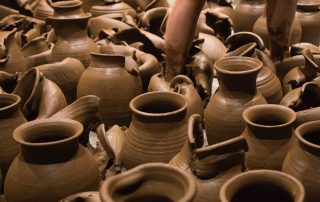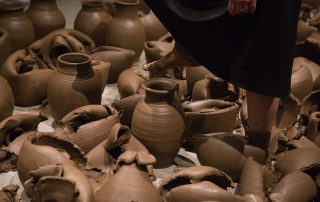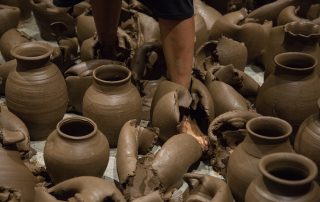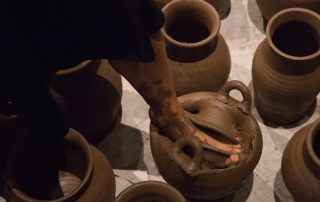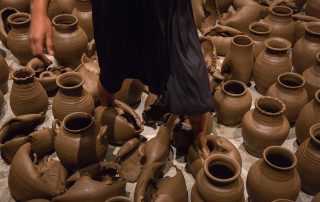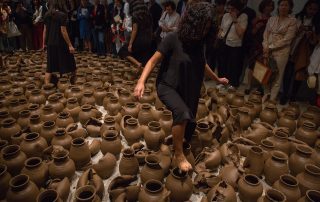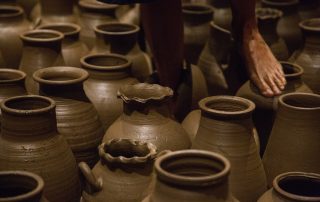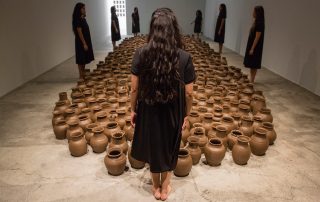HECTOR ZAMORA | MOVIMIENTOS EMISORES DE EXISTENCIA
Text and curation by Paola Santoscoy
Opening and performance: February 5, 12:00 p.m.
In recent years, Héctor Zamora’s work has been characterized by how it centers on actions involving people’s
participation: situations conceived to occur in specific contexts, from museums and galleries to public spaces, in
which body and material generate ephemeral sculptural moments that in most instances become installations. His
works manifest questions linked to site, with all the social, political and historical implications this carries. The
performance strategies, joined with the plasticity of his purely sculptural works, achieve an accumulation of
energies of different intensities that activate formal and conceptual discourses stemming from the idea of art as
something that happens.
Movimientos emisores de existencia is an action that occurs only once and later becomes an installation in the
space of the gallery. The action consists of hundreds of raw clay vessels in different shapes and sizes placed on the
floor, around which a group of women takes position. Once the performance begins, the women will walk upon the
vessels, stepping directly on them. Zamora’s intention is that the women pass over the the vessels, deforming them
step by step, expelling the air they contain, using the weight of their bodies to transform the call that almost
completely fills the space.
Movimientos emisores de existencia emerges from a fascination with the iconic figure of a woman bearing a vessel
on her head to transport water or food, which then unfolds into multiple possibilities for transporting almost
anything on the head in ergonomic perfection that is entirely efficient, elegant and sensual. Zamora has spent
several years collecting an endless number of images of people from different eras and regions of the world
carrying something on their heads, as a way of using the image to insist on an exploration of carrying and the
strength it represents. As it is a task historically assigned to women across many cultures, the feminine figure
becomes the focal point of this action in which Zamora disrupts the order of things by placing the vessel not upon
the women’s heads, but rather at their feet. By inverting the equation, what occurs is the creation of a “shared
space.”
The vessels come from a ceramics workshop in Metepec, Mexico State. The different shapes chosen by the artist are
shapes the workshop regularly produces, so there is no stylization added to these utilitarian objects. The only
variation is that they have not been fired. In several regions throughout the country these vessels can be found in
different tones an types of clay, and the tradition of bearing them on the head remains the same. This is a highly
cultured object that is very present in the imaginary, to the extent that its malleability within this situation—or
perhaps better stated, its availability to be transformed—works on a symbolic level. The rigidity of fired terra cotta
becomes flexible through the footsteps of these women who leave new forms in their wake, who exert their weight
and freedom of choice with how hard they step, whether they participate or not, in a kind of playful, collective
catharsis.
From the perspective of their utilitarian function, the vessels serve to carry something. Born by women on their
heads, with great care so that they do not fall, they are like uteruses destined for a functional, reproductive
sexuality. The act of stepping on the vessels is the expression of a powerful will made present by discharges of
physical energy and movement that transform them into vulvas, symbolizing a takeover of control, a recovery of
pleasure, a free sexuality. The many recent protests in favor of women’s right to chose for their own bodies, by “La
marea verde” in Argentina and other Latin American countries, resonates in this interpretation like a tide that
moves from generation to generation, shaping a present without the patriarchy. Still, there can be many other
interpretations. This work affirms by raising questions, not by answering them. Who are these women?
A fundamental characteristic of the actions Zamora designs is the element of loss of control as the work develops
organically, as an open system. Even when the artist gives precise instructions, there is a part of these actions that
does not depend entirely on him, but rather on the desires of those participating in it. In this way, Zamora’s pieces
open spaces for multiple interpretations while also very clearly presenting a provocation that touches urgent, often
thorny issues. La suya es una visión de la función social del arte que combina lo lúdico con el pensamiento crítico.
His is a vision of the social purpose of art as a combination of playfulness with critical thought. In this sense, the
political nature of Movimientos emisores de existencia lies not in its content, but in its capacity to “be political,”
that is to say, to intervene in the logic of the everyday, of conventions, of tradition, of the patriarchy, of the
Western gaze, of what we assume is unchangeable: to intervene in the distribution of roles in a community and in
the forms of exclusion that operate within it.
Text and curation by Paola Santoscoy
Opening and performance: February 5, 12:00 p.m.
In recent years, Héctor Zamora’s work has been characterized by how it centers on actions involving people’s
participation: situations conceived to occur in specific contexts, from museums and galleries to public spaces, in
which body and material generate ephemeral sculptural moments that in most instances become installations. His
works manifest questions linked to site, with all the social, political and historical implications this carries. The
performance strategies, joined with the plasticity of his purely sculptural works, achieve an accumulation of
energies of different intensities that activate formal and conceptual discourses stemming from the idea of art as
something that happens.
Movimientos emisores de existencia is an action that occurs only once and later becomes an installation in the
space of the gallery. The action consists of hundreds of raw clay vessels in different shapes and sizes placed on the
floor, around which a group of women takes position. Once the performance begins, the women will walk upon the
vessels, stepping directly on them. Zamora’s intention is that the women pass over the the vessels, deforming them
step by step, expelling the air they contain, using the weight of their bodies to transform the call that almost
completely fills the space.
Movimientos emisores de existencia emerges from a fascination with the iconic figure of a woman bearing a vessel
on her head to transport water or food, which then unfolds into multiple possibilities for transporting almost
anything on the head in ergonomic perfection that is entirely efficient, elegant and sensual. Zamora has spent
several years collecting an endless number of images of people from different eras and regions of the world
carrying something on their heads, as a way of using the image to insist on an exploration of carrying and the
strength it represents. As it is a task historically assigned to women across many cultures, the feminine figure
becomes the focal point of this action in which Zamora disrupts the order of things by placing the vessel not upon
the women’s heads, but rather at their feet. By inverting the equation, what occurs is the creation of a “shared
space.”
The vessels come from a ceramics workshop in Metepec, Mexico State. The different shapes chosen by the artist are
shapes the workshop regularly produces, so there is no stylization added to these utilitarian objects. The only
variation is that they have not been fired. In several regions throughout the country these vessels can be found in
different tones an types of clay, and the tradition of bearing them on the head remains the same. This is a highly
cultured object that is very present in the imaginary, to the extent that its malleability within this situation—or
perhaps better stated, its availability to be transformed—works on a symbolic level. The rigidity of fired terra cotta
becomes flexible through the footsteps of these women who leave new forms in their wake, who exert their weight
and freedom of choice with how hard they step, whether they participate or not, in a kind of playful, collective
catharsis.
From the perspective of their utilitarian function, the vessels serve to carry something. Born by women on their
heads, with great care so that they do not fall, they are like uteruses destined for a functional, reproductive
sexuality. The act of stepping on the vessels is the expression of a powerful will made present by discharges of
physical energy and movement that transform them into vulvas, symbolizing a takeover of control, a recovery of
pleasure, a free sexuality. The many recent protests in favor of women’s right to chose for their own bodies, by “La
marea verde” in Argentina and other Latin American countries, resonates in this interpretation like a tide that
moves from generation to generation, shaping a present without the patriarchy. Still, there can be many other
interpretations. This work affirms by raising questions, not by answering them. Who are these women?
A fundamental characteristic of the actions Zamora designs is the element of loss of control as the work develops
organically, as an open system. Even when the artist gives precise instructions, there is a part of these actions that
does not depend entirely on him, but rather on the desires of those participating in it. In this way, Zamora’s pieces
open spaces for multiple interpretations while also very clearly presenting a provocation that touches urgent, often
thorny issues. La suya es una visión de la función social del arte que combina lo lúdico con el pensamiento crítico.
His is a vision of the social purpose of art as a combination of playfulness with critical thought. In this sense, the
political nature of Movimientos emisores de existencia lies not in its content, but in its capacity to “be political,”
that is to say, to intervene in the logic of the everyday, of conventions, of tradition, of the patriarchy, of the
Western gaze, of what we assume is unchangeable: to intervene in the distribution of roles in a community and in
the forms of exclusion that operate within it.

